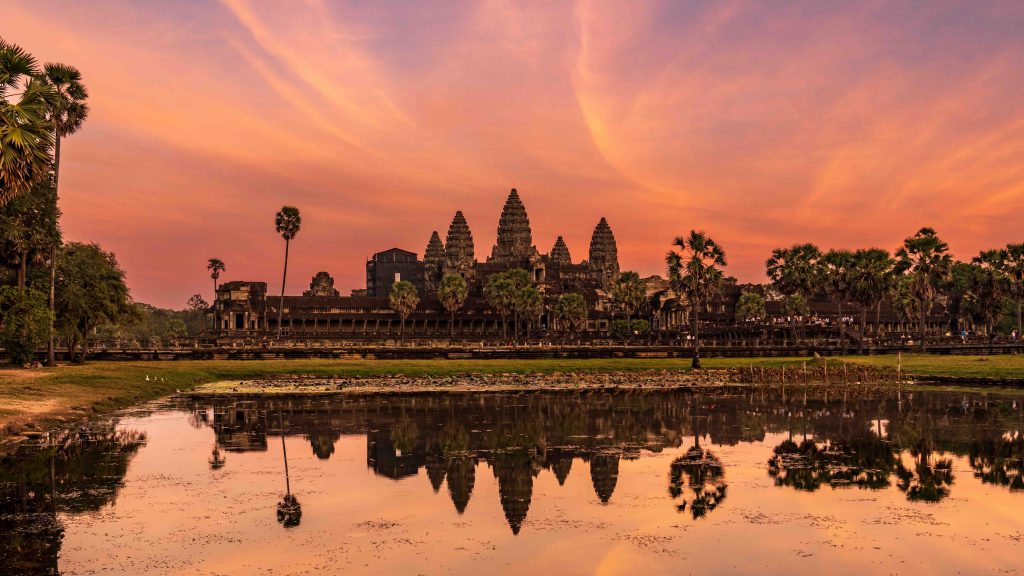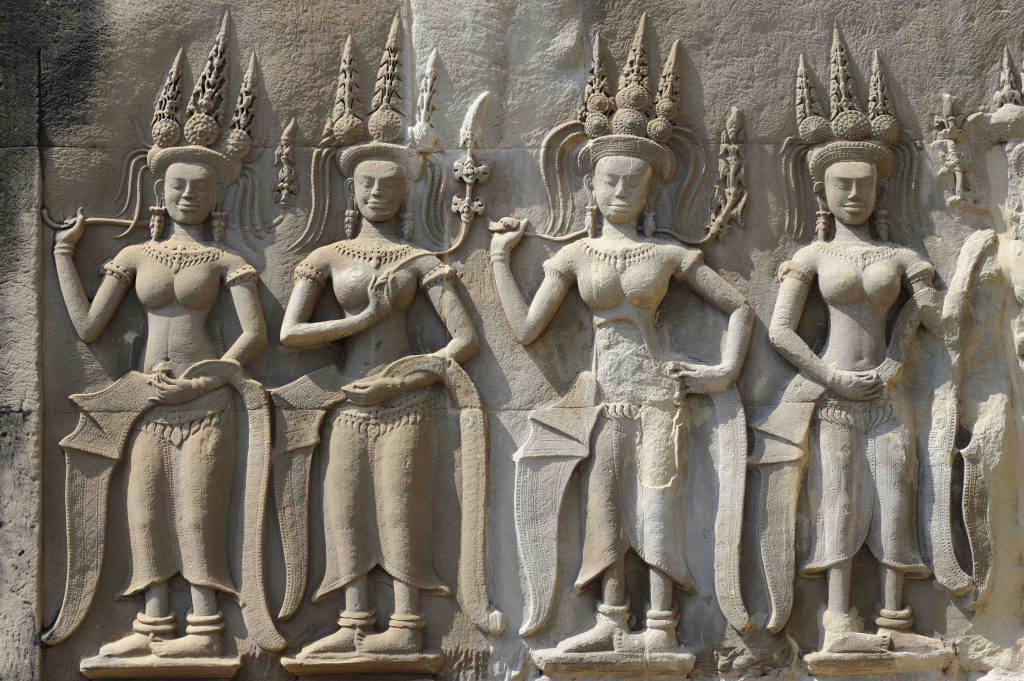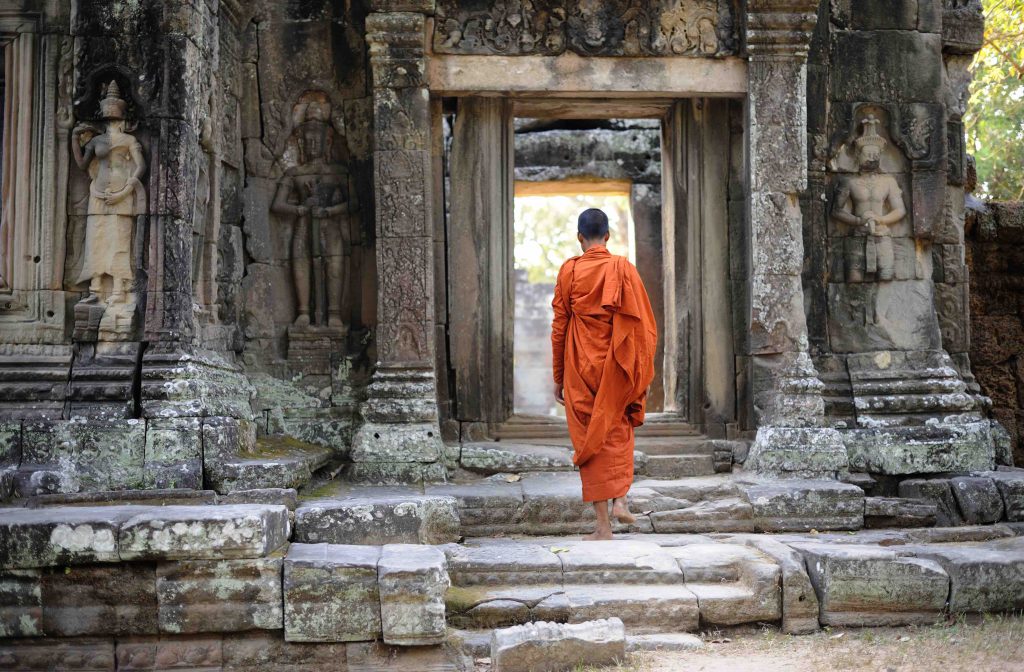Truong Quy
The afternoon sun paints a golden sheen on the Bayon’s stone towers, nestled in an ancient forest, highlighting stones shaped like lotus buds and enigmatic faces, which gaze in four directions, smiling mysteriously. This is Angkor, once known to the Vietnamese as “De Thien De Thich”. The splendor of the past endures in these temples, which are among the most famous heritage sites in the world.

A majestic and sacred realm
Researches describe Angkor as the world’s first megacity, having served as the capital of several Khmer dynasties from the late-9th to 15th centuries. A contemporary witness, the Yuan dynasty scholar Zhou Daguan, described the grandeur of the Khmer capital in his book The Customs of Cambodia, detailing a visit to Angkor in 1295: “In the city, there is a golden tower, surrounded by more than 20 stone towers and over 100 stone houses, all oriented toward the golden bridge to the east. On both sides of the bridge are two golden lion statues, and below the stone houses are eight golden Buddhas… Merchant ships from various places come here, praising “the wealth of Cambodia” when referring to this place”. When compared with the current site, Zhou Daguan’s descriptions don’t seem exaggerated.
Bearing Buddhist influences and Hindu architectural elements, the Angkor complex includes Angkor Wat (the temple city), Angkor Thom (the great city), and over 1,000 temples scattered around the area. Built in the 12th century, Angkor Wat features a nearly square rectangular layout and an architecturally perfect geometric structure. Enclosed by a sandstone wall with a perimeter of 3.6 km, the temple complex consists of a three-tiered structure with five towers. The central tower reaches 65 meters high, symbolizing Mount Meru in Hindu and Buddhist beliefs. To reach the top tier of Angkor Wat, visitors must climb unusually steep steps with a slope of up to 45 degrees. The caution required to scale each step seems to enhance the overwhelming sense of awe at the majesty of this sacred realm, contrasting with the mundane nature of human existence.

Silent smiles
With its classically perfect layout, Angkor Wat has become a national symbol, even appearing on the national flag. Angkor Thom, with the Bayon at its center, represents the pinnacle of artistic spirit. The remaining 54 towers are carved with 216 colossal faces, all exuding serenity in their tranquil smiles. Rising toward the center, the temple resembles a silent gathering of giants in an ancient forest when viewed from afar.
Exploring these sites is only the start of a visit to Angkor, a vast area of ruins including the Terrace of the Elephants, the Terrace of the Leper King, Baphuon Temple—once considered the Forbidden City, where the king resided, and dozens of other relics that remain splendid even as ruins, such as a row of giant elephant statues and an entrance flanked by sculptures of deities holding the serpent Naga. Outside the walls of Angkor Thom lie other famous temples rediscovered after Cambodia opened its doors to tourism, among which Ta Prohm and Preah Khan stand out. After centuries of neglect, these temples were overtaken by giant kapok and banyan trees, their roots resembling enormous pythons constricting the stone structures. These sites were featured in spectacular scenes in the adventure fantasy film Lara Croft: Tomb Raider, starring Hollywood actress Angelina Jolie in 2001.

The dance or the shape of a nation
The most exquisite beauty of Angkor lies in the statues and carvings of Apsara dancers. Everywhere from long corridors to the narrow crevices between the Bayon stone towers lie stories carved in stone, like a 2.5-meter high relief stretching over 800 meters. The longest hand-carved stone relief in the world, it depicts legends from the classic Indian Brahmanical epics Mahabharata and Ramayana.
“Apsara, oh the dance or the shape of a nation!” proclaims “The Volunteer Soldier and the Apsara Dance”, a song by Minh Quang. Indeed, 1,700 Apsara dancers in famous dance poses soften the raw stone and solemn mystery with their graceful faces and perfect bare chests. Meanwhile, Banteay Srei (the temple of women), located 25 km north of Angkor Thom, is unique for the femininity of its red sandstone sculptures. The rare red stone contrasts with the green, yellow, and gray stones of the main complex, and the intricate carvings of dancers and vine patterns create an alluring contender in the “competition” for the most beautiful among Angkor’s 45 monument clusters.
Continuing 14 km toward the sacred Mount Kulen lies Kbal Spean Stream, where thousands of lingas were carved in 1050. This site embodies the ancient Khmer belief that bathing in this stream brings health and prosperity. Visitors are constantly amazed by the boundless creativity of the civilization’s artisans, forgotten and then gloriously revealed again like a rebirth.
Returning to the charming city of Siem Reap, amidst the hustle and bustle of a tourist town that draws visitors from all over the globe, visitors who love the past can still imagine the sunset casting its glow over the smiling faces of the Bayon’s towers and following them to the river as it flows past streets lined with familiar colonial architecture.










